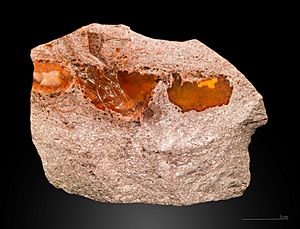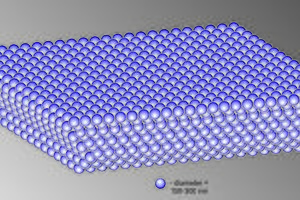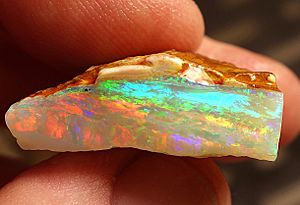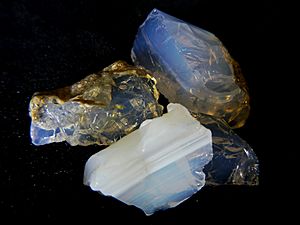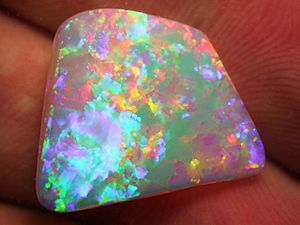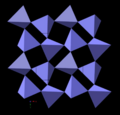Opal facts for kids
Quick facts for kids Opal |
|
|---|---|
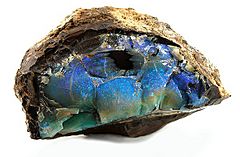
A rich seam of iridescent opal encased in matrix
|
|
| General | |
| Category | Mineraloid |
| Formula (repeating unit) |
Hydrated silica. SiO2·nH2O |
| Identification | |
| Color | Colorless, white, yellow, red, orange, green, brown, black, blue, pink |
| Crystal habit | Irregular veins, in masses, in nodules |
| Crystal system | Amorphous |
| Cleavage | None |
| Fracture | Conchoidal to uneven |
| Mohs scale hardness | 5.5–6 |
| Luster | Subvitreous to waxy |
| Streak | White |
| Diaphaneity | opaque, translucent, transparent |
| Density | 2.09 |
| Polish luster | Vitreous to resinous |
| Optical properties | Single refractive, often anomalous double refractive due to strain |
| Refractive index | Mexican opal may read as low as 1.37, but typically reads 1.42–1.43 |
| Birefringence | none |
| Pleochroism | None |
| Ultraviolet fluorescence | black or white body color: inert to white to moderate light blue, green, or yellow in long and short wave, may also phosphoresce, common opal: inert to strong green or yellowish green in long and short wave, may phosphoresce; fire opal: inert to moderate greenish brown in long and short wave, may phosphoresce |
| Absorption spectra | green stones: 660 nm, 470 nm cutoff |
| Diagnostic features | darkening upon heating |
| Solubility | hot salt water, bases, methanol, humic acid, hydrofluoric acid |
Opal is a beautiful mineral that looks like a rock. It is the special birthstone for anyone born in October. Opals are made from tiny balls of silica (which is another mineral) and a lot of water.
Contents
Types of Opal

Opals come in different types, but the most famous is precious opal. This kind of opal shows a dazzling mix of colors inside it. These colors seem to move and change as you look at the stone. This amazing effect is called "play of color."
Precious Opal's Play of Color
Precious opal has a special internal structure. Under a microscope, you can see it's made of tiny, perfectly round silica spheres. These spheres are arranged in neat rows, like marbles in a box. When light passes through these tiny spheres, it bends and splits into different colors. The way the spheres are spaced out decides which colors you see. This is similar to how a CD or DVD can show rainbow colors.
The colors you see depend on how far apart the rows of spheres are. It also depends on the angle you look at the opal. This special effect is why precious opals are so valuable and unique.
Common Opal
Not all opals show the "play of color." These are called common opals. They might be milky, bluish, or greenish. Some common opals are still very pretty and can be used as gemstones.
Other types of common opal include:
- Milk opal: A milky white or bluish-green opal.
- Resin opal: A honey-yellow opal that looks a bit waxy.
- Wood opal: This happens when wood turns into opal over a very long time.
- Hyalite: A clear, glass-like opal, sometimes called Muller's glass.
- Geyserite: Opal that forms around hot springs and geysers.
- Diatomaceous earth: This is made from tiny fossil shells of diatoms, which are a type of algae. Their shells are made of opal!
Other Special Opals
Fire opal is a transparent or see-through opal. It has warm colors like yellow, orange, or red. Usually, it doesn't show a "play of color," but sometimes you might see bright green flashes. The most famous fire opals come from Mexico. If they don't show play of color, they are sometimes called "jelly opals."
Girasol opal is a type of clear opal that has a bluish glow. This glow seems to follow the light source around. It's not the same as the "play of color" in precious opal. You can find this type of opal in Oregon and Mexico.
Peruvian opal (also called blue opal) is a blue-green stone found in Peru. It's usually not transparent and doesn't show a play of color. Blue opal is also found in Oregon and Nevada.
Where Opals Are Found
Opal was very rare and valuable a long time ago. For many years, the only known source in Europe was in Slovakia. But in the 1800s, huge deposits were found in Australia.
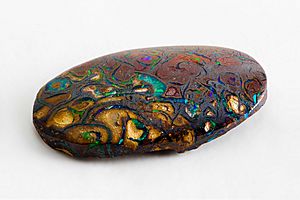
Australia has been the biggest supplier of precious opal for a long time. However, in recent years, other countries like Ethiopia have also become important sources.
Australia
The town of Coober Pedy in South Australia is a major place for finding opal. In 1956, the largest and most valuable gem opal ever, called "Olympic Australis," was found there. It weighed about 37 pounds (17 kg)!
Another important area is Lightning Ridge in New South Wales. This is the main place where black opal is found. Black opal has a dark background, which makes its play of color look even more vibrant.
Boulder opal is found in Queensland. It's opal that forms within a dark ironstone rock. Australia is also famous for finding fossil remains, like dinosaur bones and marine creatures, that have turned into opal!
Ethiopia
People might have used opal in Northern Africa as early as 4000 BC. But it wasn't until 1994 that precious opal was officially reported in Ethiopia. This early Ethiopian opal was often dark brown and tended to crack easily.
In 2008, a new and better opal deposit was found near Wegel Tena in Ethiopia. This new opal, often called "Welo" opal, looks a lot like the opals from Australia. It has a light background and bright play of color. Welo opal has become very popular in the gem world.
Virgin Valley, Nevada
The Virgin Valley opal fields in Nevada, USA, produce many kinds of precious opal. This includes black, crystal, white, fire, and lemon opals. The black fire opal is even the official gemstone of Nevada!
Many of these opals formed inside ancient wood. Some of the opals found here have a lot of water and can crack if they dry out too quickly. The largest unpolished black opal in the Smithsonian Institution, called the "Roebling opal," came from the Rainbow Ridge Mine in Virgin Valley. It weighs about 1.1 pounds (0.5 kg)!
Mexico
Mexico is another important place for finding opal, especially in the state of Querétaro. Mining for opals was very active there in the 1960s and 70s. Today, it's harder to find high-quality opals with a lot of "fire" (play of color).
The oldest mine in Querétaro, Santa Maria del Iris, opened around 1870. There are many opal mines in Mexico, but most are now closed. The best opals from Mexico often came from Santa Maria del Iris.
Related pages
Images for kids
See also
 In Spanish: Ópalo para niños
In Spanish: Ópalo para niños


